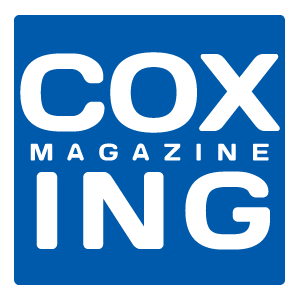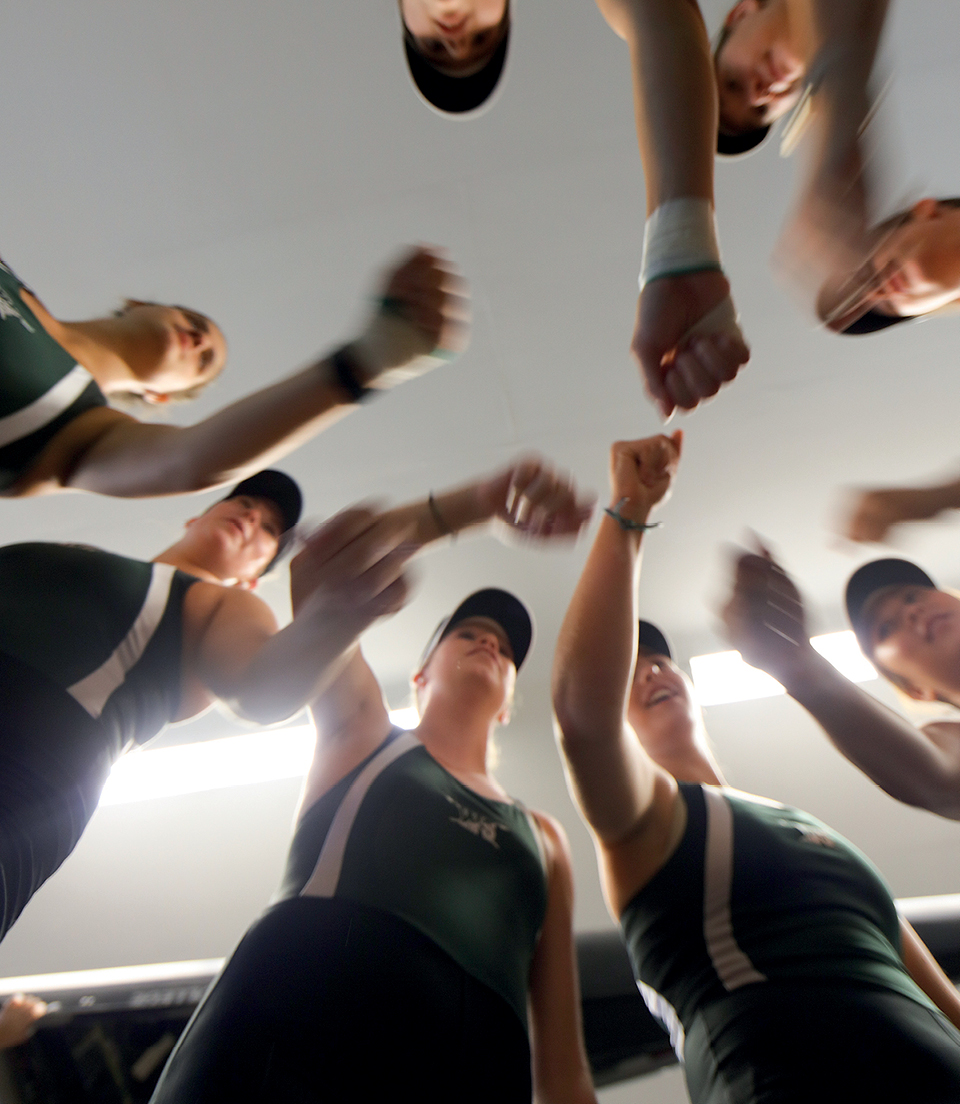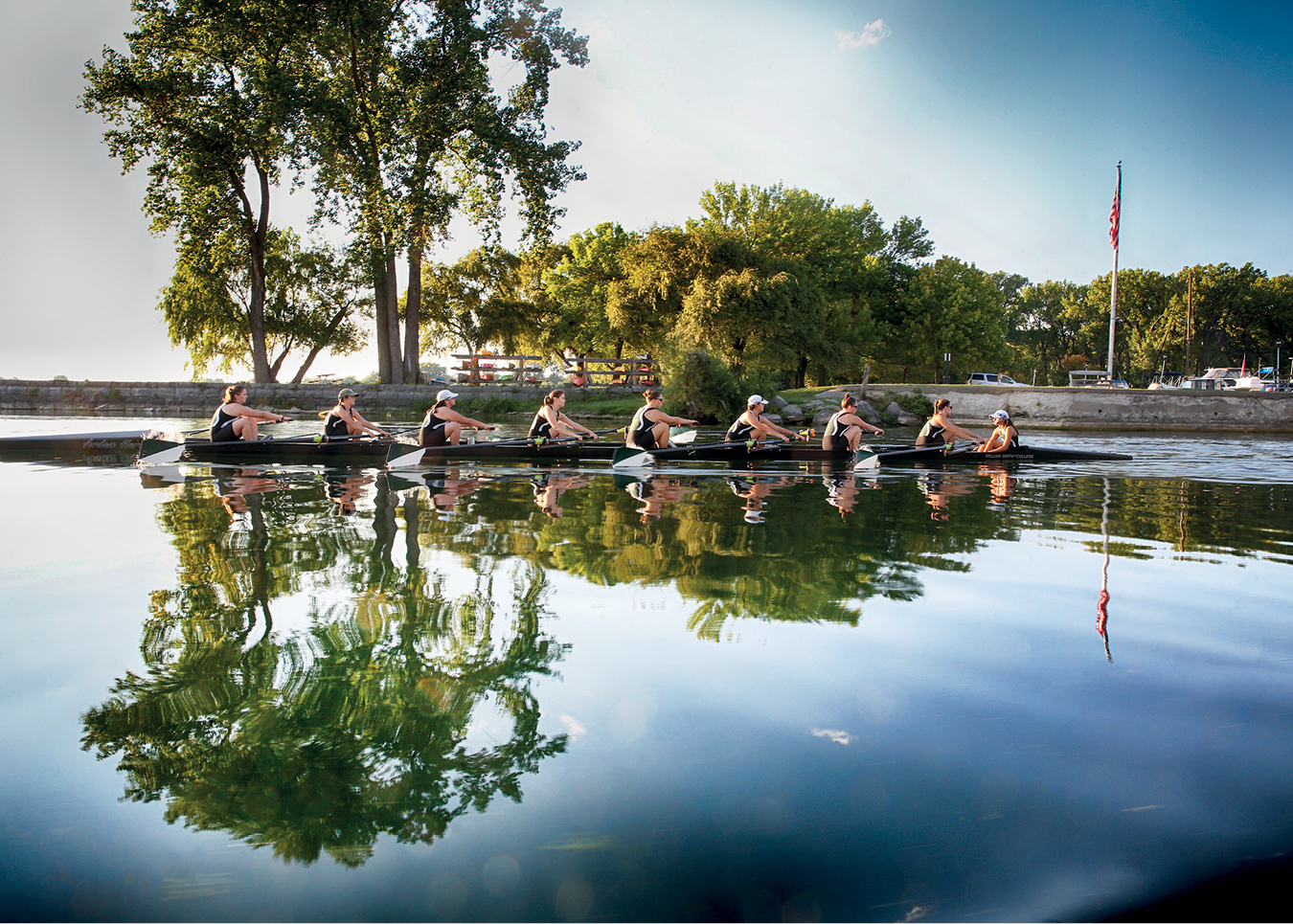How Sandra Chu Creates Community in Rowers and Coxswains
Story by Jen Whiting
Photos by Kevin Colton/Hobart and William Smith Colleges
“Everything you need is within 25 feet of you.” Sandra Chu is petite, like many coxswains are. “Everything you need to solve most of the problems you face is within a 25-foot circle. Turn around; you’ll find a person, Google, spare parts. You can usually solve any problem using what you have inside that circle.”
Chu, who started her career as a coxswain at Princeton in the late 1980s, is now the head coach of women’s crew at William Smith College in upstate New York; she’s led the women’s rowing program at William Smith since 2002. “It’s crazy, doing everything we need to do in nineteen weeks of practice.” Chu starts off by educating me about the Division III schedule. Seven weeks of coached-practices are allowed in the fall and twelve weeks of coached-practices in the spring. “D-III is definitely a teaching environment,” she says. After graduating from Princeton in 1991, Chu earned a master’s degree in English and Creative Writing from New York University then headed back to the boathouse she had coxed out of during her collegiate career.
After a season of coaching at Princeton, Chu joined the staff at Kansas State as an assistant coach under Jenny Hale. Three years later she took the helm at William Smith. “There are a lot of things I love about Division III. I work at a fantastic institution. We have an athletic director who believes in what we’re doing. If we want to try new things, we have the resources we need. And, coaching is a great opportunity to show students that everything you need to solve a problem is within a 25-foot circle.”
Chu has the coxswain’s voice: commanding and flowing in delivery, yet ebbing when she wants to draw you in. “Coaching is about teaching problem-solving skills. It’s a great opportunity to put that out there: that everything you need is right here. The women who leave my program don’t see problems; they see solutions.”
William Smith College sits on the northern-most end of Seneca Lake, one of the New York Finger Lakes. It shares a campus with Hobart College and together the two colleges offer a distinctive heritage of liberal arts interdisciplinary education and research. Chu has worked for the past fourteen years to build a program that has a culture of community and excellence. The finish line has shown her crews to be at the top of their league, season after season. In the past fourteen seasons Chu has led her team to the NCAA Championships eight times and to the Liberty League Championships nine times. Of course, this is what every coach strives for, what all the winning programs are built on. I ask Chu about her approach to building a specific culture–a distinct work ethic–among her athletes.
Hannah Glenshaw, the William Smith 1V coxswain, performs during a practice
“The trick to being consistently successful is not to have cycles, but to have the norm,” she says. As she speaks, I can imagine her voice through a coxswain’s microphone, the crackle of wires carrying her words. I ask her how she finds coxswains at William Smith. “Every five-foot person has a six-foot friend,” she smiles, “and I think it goes both ways. During our walk-on scan, (she and her rowers and assistant coaches position themselves at the exit doors of the fall orientation session and scan the room) my rowers and coaches are talking to the tall students–people who look like them–and I’m looking for the smaller person. The one who looks organized.”
Chu was a walk-on coxswain at Princeton in 1988 and her approach to finding recruits stems from that. “I didn’t think I was going to row at Princeton. Actually, the coaches made it pretty clear I wasn’t going to row.” Chu is just over five-feet tall and was a tennis player in high school. When she asked the Princeton novice coach if she could try rowing even if she’d never rowed before, her question was met with a chuckle; she promptly learned that rowing wasn’t going to be in her future but that there was another seat in the boat that might suit her better. After being convinced by some friends that she was just right to cox, Chu joined the team and led the Tigers to medals at the Head of the Charles and the EAWRC Sprints Championships.
Chu knows firsthand that being a walk-on coxswain is not easy. “You get recruited [as a walk-on] and put in the seat. They say, ‘Here’s a $35,000 boat and eight other people. Good luck.’ When I’m looking for walk-on coxswains, I look for someone who looks like she can respond to input, is pretty smart, and has social capital.” Chu thinks back on her collegiate career and says, “There was so much that I didn’t learn in those four years that I’ve learned since then. There are so many connections I have to help my coxswains get to sooner. I want them to have Junior-year speed as a first-year cox.
“In high school, a lot of coxswains believe the only way to get speed is to yell. There are so many other, better ways. First year coxswains don’t yet understand that a big part of their relationship with the crew is to listen to all the voices of their rowers and script their monologue–and dialogue–accordingly. A coxswain needs to know that if she’s going to cox eight rowers, she may need three or four different styles in a seven minute race. If I can teach that in the first year, we’re ahead.”
I think about what it would be like to be coached by someone who has been in the cockpit, someone who has pried her toes along the inside of the hull of a bow-loaded Four, someone who has looked across the lanes to gauge the next move. And then, I ask Chu–this coxswain-turned-coach who has transitioned her perspective to the launch with seeming ease–what impact her coxing has on her coaching. “It’s very regimented, how I approach the coxswain’s education, how we develop the Cox'n Corps. I love coxing; I love that seat. As a cox, and as a coach, I believe I’m going to make the boat go faster. It’s exciting to help people reach their very best performance. In my career, I’ve been about transformation. I want to take a student and when she’s done, she feels like she can rock the world. She’s done the hard work. She’s failed, been resilient, been gritty. Those are the skills of the coxswain seat. They know they’re the wizard behind the curtain, and it's OK that nobody else knows it.”
Chu goes on, “If I, as a coach, can correct something and ask my coxswain if they felt how the hull changed, then she’ll know what to correct. If you can speed up the teaching of those kinds of changes, you’re ahead.”
Sandra Chu
As we talk, I feel myself bracing a bit. Most coxswains know when something is good, and when it needs correcting. I knew, as I listened to her words, that writing Sandra’s Chu’s story would feel much like coxing for her would: getting the tone just right, relaying her messages in the right way. Writing about a coxswain is as nerve-wracking as writing can get. Coxswains have big voices; it's best not to talk in the boat, if you will.
“Everyone likes to be good at our jobs,” Chu seems to be reading my mind. “It’s important to remember that it’s easy to yell when things go wrong. It’s not as easy to remember to say, ‘You did that well.’ During practice, I ask the boats to level up, bowball to bowball in two strokes. The coxswains know I expect them to keep the boats together as we build into a piece. They get that praise–loudly–over the megaphone. They know they’re making things better–creating space for the rowers to improve.”
During the 2012-2013 season, William Smith was third in the nation; they had unprecedented success. Then, two years later, as Chu was rebuilding her crew after her seniors graduated, her most experienced coxswain came into her office to talk. The cox knew her crew wasn’t going to be as competitive as previous crews, but still she wanted to give everything she could to the team. “I know we’re not going to have the same speed this year, but I’m done being sad about it. I’m a Senior and I know I’m not going to have ‘the year.’ Tell me what you need. How do I leave this program so that it can have the speed in the future?” Chu explains, “Everything that coxswain did from that day forward was focused on that goal. She gave leadership positions to others, she explained things to younger coxswains. She was infectious, and it wasn’t for herself. She would say to her teammates, ‘We’re going all in because that’s what we can do.’” Chu gets pensive as she finishes the story. “It takes a team player to be that ‘team first.’” And so we’re back to building a culture of community in the team. I probe into the changes Chu has seen in her nearly-two decades of coaching.
“What we’re seeing now is that students want an ‘Easy Button.’ Our students have a hard time understanding that it takes a long time to be successful. Your coaching has to change. You have to figure out what makes Millennials go. Sometimes you have to be the anti-thesis of everything they’ve experienced. I’ve had kids that I’ve been the first person that has said ‘No’ to them.
“Here’s what’s important: failure is often a win.” Chu slows down here and I wait, sensing that this is what has driven her to refine her coaching, this is what has pushed her to seek to understand her athletes beyond just their outward appearances. Chu seeks to understand what drives their personality type, what motivates each of her athletes beyond their previous best.
“We’ve designed practices where they can’t succeed. I teach the coxswain to say, ‘We didn’t get that number, but here’s what we did do.’ I want her to grow her ability to be mentally resilient. The coxswain is a statistician, a historian.” Chu asks her coxswains to be the team statisticians during winter training, as well as during the on-the-water workouts. She maintains logs of every workout her team has done (since 2003). “Every workout, every student. I’m a big fan of technology. We use a shared data sheet in OneNote.” To her great disappointment, she says, Google Sheets doesn't allow the entry of tenths of a second. She shares the OneNote data sheets with all of her rowers, coxswains and coaches. During erg workouts, her coxswains work together to divide the 40 rowers into groups they can effectively manage and ensure everyone’s workout data is recorded.
The coxswain dashboard Chu fabricates for her boats
During on-the-water practices, coxswains are given a performance objective beforehand. Every semester, her team receives the entire season’s schedule–with workouts–on the first day of practice. Says Chu, “I expect they are fueling and hydrating and managing their schedule accordingly, so they aren’t burning the candle at both ends.” Chu sends out a daily e-mail with the boatings and the practice details. “Once the students get to the boathouse I don’t have to talk. The coxswains run the practice. All I have to do is coach. That is enormously freeing when you’re on a college schedule. I’m only using airtime to make people faster.”
Chu hasn’t always turned over the details to her students so successfully. “The first year or two I struggled,” she says. “I was doing everything myself.” She reflects on what brought about the change in her style. “It’s always about what’s inside of me. What can I change about me? The older I get–and having a child–you have to let go of something. The looser I get, the better the team is. The question always is, how can I get looser without letting things fall through the cracks?”
Chu lets her thoughts break through the surface, unprompted. “There’s one thing I’m not willing to give up. I do value the student's academic experience at William Smith. I want them to be successful in the classroom. They do great things here.”
I ask her one last question, the one that’s been on my mind since we started. “Did you know it would be successful to transition from coxswain to coach?” She waits a moment, remembering, before answering. “When I was deciding to be a rowing coach, I had a hard time getting a job. At first I took it personally. I’ve watched–and been on–the coaching carousel. I turned to Lori [Dauphiny, the women’s head coach at Princeton] and said, “Is it because I’m a coxswain?” She said, “No, of course not. Look at Yasmin [Farooq]. It’s OK.”
Chu continues, "I realized I knew much more than I thought I knew about the actual rowing stroke. Did I know this was going to work out, this transition from coxswain to coach?” I see the light passing from the room, a slow softening of the glow of the day, as she answers her own question. “As a coxswain, it’s all about marshaling resources around you and making sure the language you’re using reflects how the hull feels.”
She looks up and brings us back to the beginning. “When there are problems, we look 25 feet around us. I try to teach the team that there are different ways to get it done right, and everything we need is within reach. I try to coach more like that.”
The William Smith Rowing culture of community
"A lot of coxswains believe the
only way to get speed is to yell.
There are so many other,
better ways."
William Smith has access to over five miles of calm, protectedwater in the Cayuga-Seneca Canal and 40 miles on Lake Seneca







